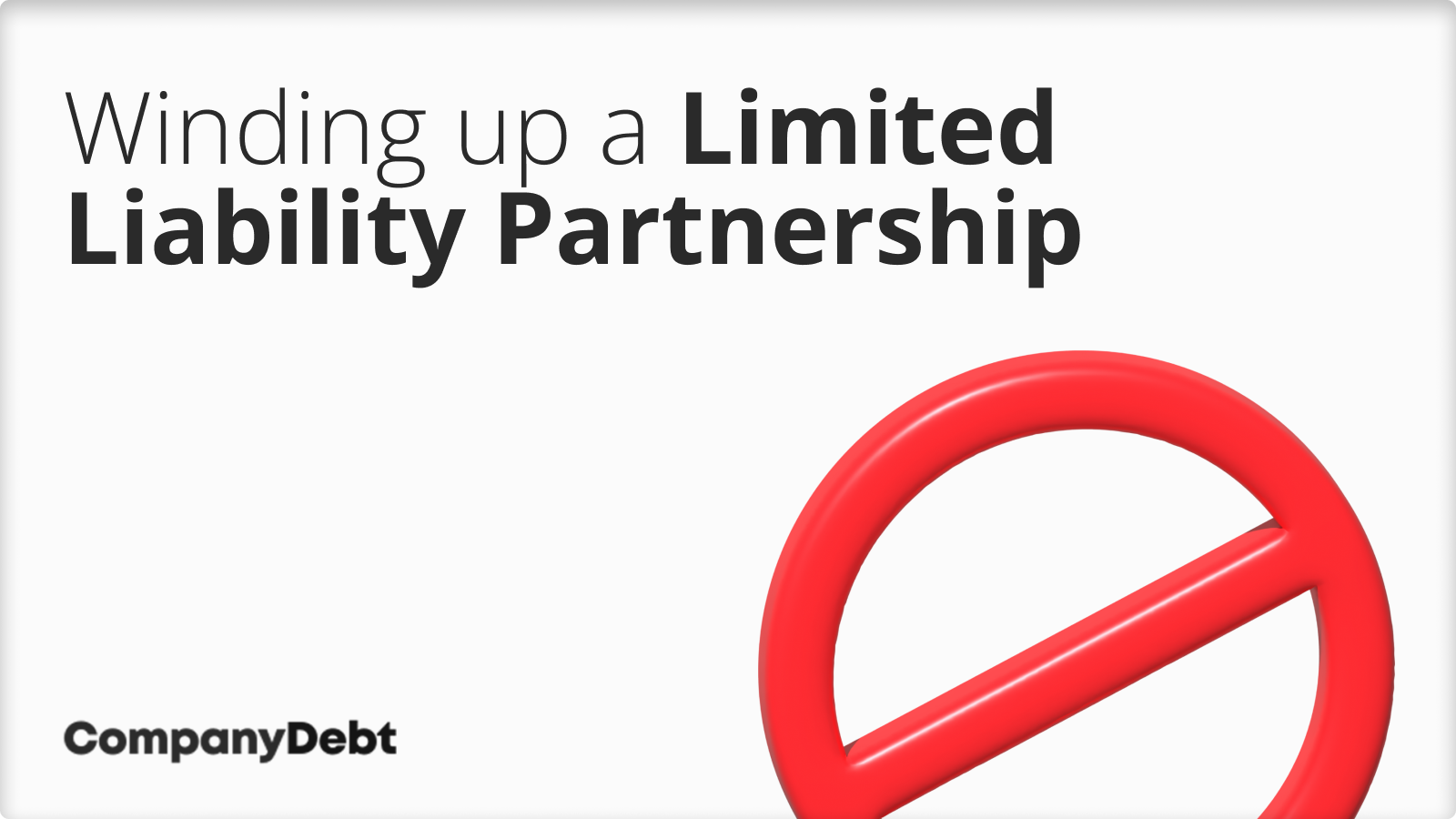
Winding up a Limited Liability Partnership
Winding up an LLP can be initiated voluntarily by you and your partners, or it may be forced by creditors if your LLP is struggling with debt.
If the choice to close down is voluntary, all partners must be in agreement.
I’ll provide an overview of the winding-up process, including:
- Different scenarios for voluntary and compulsory winding-up
- Steps involved in each type of winding-up
- Important considerations for partners

Winding Up of a Solvent LLP
When you decide to close your LLP voluntarily, you have two main options: voluntary strike-off (dissolving the company)[1]Trusted Source – GOV.UK – Limited liability partnership (LLP) strike off or Members’ Voluntary Liquidation (MVL).
You might consider this option if:
- You’re retiring with no successor to take over the business
- Your LLP’s membership has fallen below the required two members
- Your LLP is a subsidiary that’s no longer needed
- The business idea you set up to explore proved unfeasible
- Your LLP is dormant or non-trading
MVLs, which come with tax benefits, are usually chosen when the LLP has assets over 25k. Strike-off is a simple and affordable means to close the LLP yourself without the assistance of an insolvency practitioner.
Voluntary Strike Off (Dissolution)
A voluntary strike-off is suitable if your LLP is solvent and has ceased trading.
To qualify, your LLP must not have traded, sold off property, changed names, been threatened with liquidation, or had agreements with creditors in the last three months.
To initiate a voluntary strike-off, you’ll need to:
- Gain agreement from all LLP members
- Settle any outstanding debts
- File final accounts and tax returns
- Inform HMRC, employees, pension fund trustees, and other interested parties
- Submit form LL DS01 to Companies House with the required fee
You can also use the HMRC online service to close your LLP.
NB: After an LLP is dissolved, any assets it still owns become “bona vacantia” – meaning “ownerless goods”, and automatically pass to the Crown. It’s crucial to deal with all assets before dissolution to avoid this situation, as recovering bona vacantia assets can be complex and costly.
Members Voluntary Liquidation
If your LLP has significant assets to distribute, you might consider an MVL. This process involves appointing a licensed insolvency practitioner to formally wind up your solvent LLP.
As such, it comes with professional fees, but these can be offset by the tax benefits if the company is large enough. MVLs allow you to benefit from a 10% tax rate on lifetime gains of up to £1 million under Business Asset Disposal Relief.
Here are the steps involved:
- The members convene to pass a resolution for voluntary dissolution. This requires a majority vote, both by the number of members and by the value of their capital contributions.
- A liquidator (licensed insolvency practitioner) is appointed to oversee the winding-up process.
- The liquidator notifies Companies House of the dissolution by submitting the required form, either online or by post.
- The liquidator is responsible for settling any outstanding debts and liabilities of the LLP.
- After debts are cleared, the liquidator distributes the remaining assets to the members according to the terms of the LLP agreement.
- The liquidator submits a strike-off application to Companies House. The LLP will officially be dissolved three months after the application is processed, concluding the dissolution.
Winding up an Insolvent LLP
Creditors Voluntary Liquidation
If your LLP is insolvent and you’ve decided to close it, you can initiate a Creditors’ Voluntary Liquidation (CVL)[2]Trusted Source – GOV.UK – Limited liability partnership liquidation and insolvency. This process allows you to voluntarily wind up your LLP while ensuring fair treatment of creditors.
To begin a CVL, you’ll need to:
- Call a meeting of LLP members to propose winding up
- Appoint a licensed insolvency practitioner as liquidator
- Notify creditors of the liquidation and invite them to a creditors’ meeting
- Prepare a statement of affairs detailing the LLP’s assets and liabilities
The liquidator will take control of your LLP’s affairs, realise assets, and distribute proceeds to creditors. They’ll also investigate the LLP’s failure and the conduct of its members.
Opting for a CVL when your LLP is insolvent offers several advantages. It demonstrates to creditors that you’re taking responsible action, potentially reducing the risk of wrongful trading allegations. It also gives you more control over the process compared to compulsory liquidation.
However, be aware that a CVL doesn’t automatically protect you from personal liability. If you’ve given personal guarantees for LLP debts or if wrongful trading is proven, you may still face financial consequences.
Remember, timing is crucial when considering a CVL. Acting promptly when you recognise insolvency can help maximise returns for creditors and minimise risks to you as a member. If you’re unsure about your LLP’s financial position or the best course of action, seek professional advice without delay.
Compulsory Liquidation of an LLP
When your LLP faces financial difficulties, creditors may initiate compulsory winding up. This process begins when a creditor, often HMRC, petitions the court to close your LLP due to unpaid debts.
Typically, a creditor can petition for your LLP’s winding up if you owe them £750 or more. However, the debt is usually much higher due to the costs involved. Once a winding-up petition is issued, you have just seven days to respond or settle the debt.
If you fail to act, your LLP’s insolvency will be advertised in The Gazette. This can have severe consequences:
- Your LLP’s bank accounts may be frozen
- Your ability to trade will be severely restricted
- Other creditors may join the petition
If the court supports the petition, it will issue a winding-up order. An official receiver or insolvency practitioner will then be appointed to liquidate your LLP’s assets and investigate the conduct of the members.
Can you Prevent the Winding up of an LLP?
It’s crucial to act quickly if you receive a winding-up petition. You may still have options to save your LLP, such as negotiating with creditors or entering a Company Voluntary Arrangement. However, these options become more limited as the process advances.
Remember, compulsory liquidation can have serious personal consequences for LLP members, including potential disqualification from acting as a director. If you’re facing the threat of compulsory winding up, seek professional advice immediately to understand your options and protect your interests.
Can the Members of an Insolvent Limited Liability Partnership be Held Personally Liable for Debts?
Typically, members of an LLP enjoy limited liability protection. This means that their personal assets are generally protected, and they are not personally liable for the LLP’s debts, provided there is no evidence of wrongful or fraudulent trading.
If the members have provided personal guarantees for any of the LLP’s debts, those members will be personally liable to the extent of the guarantee. This can include loans, leases, or other financial commitments made under such guarantees.
During the insolvency process, if there is an indication that the members acted wrongfully or fraudulently in the management of the LLP (such as continuing to trade when the LLP was insolvent), they can be held personally liable for the LLP’s debts. Legal actions can be initiated against them, which might include disqualification from serving as a director or in the management of any company.
Members of an insolvent LLP may face restrictions on forming or managing another company or LLP if they are found responsible for mismanagement or insolvency-related offences.
FAQs on Winding up an LLP
What happens if an LLP is insolvent?
If an LLP is insolvent, it may undergo a creditors’ voluntary winding up or be forced into compulsory liquidation by a court order. An insolvency practitioner will be appointed to liquidate the LLP’s assets, pay creditors, and complete the dissolution process.
Can disputes among LLP members affect the winding up process?
Yes, disputes among members can complicate the winding up process. It is advisable to resolve any disputes or agree on a clear procedure for winding up before initiating the process to avoid delays and legal complications.
What should LLP members do to prepare for winding up?
LLP members should ensure accurate and up-to-date accounting records, settle as many debts as possible, and consult with a legal or financial advisor to understand the implications of winding up. It’s also crucial to notify all creditors, employees, and clients about the LLP’s dissolution.
The primary sources for this article are listed below, including the relevant laws and Acts which provide their legal basis.
You can learn more about our standards for producing accurate, unbiased content in our editorial policy here.
- Trusted Source – GOV.UK – Limited liability partnership (LLP) strike off
- Trusted Source – GOV.UK – Limited liability partnership liquidation and insolvency







